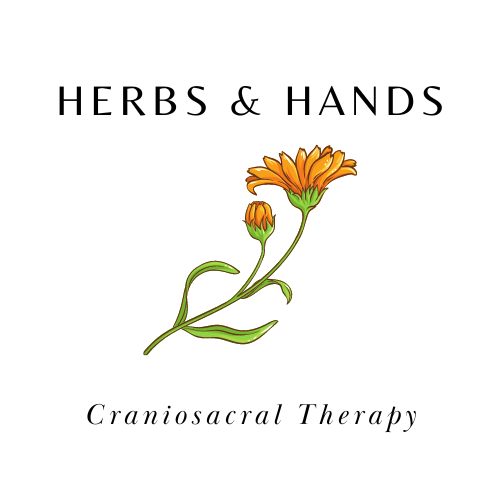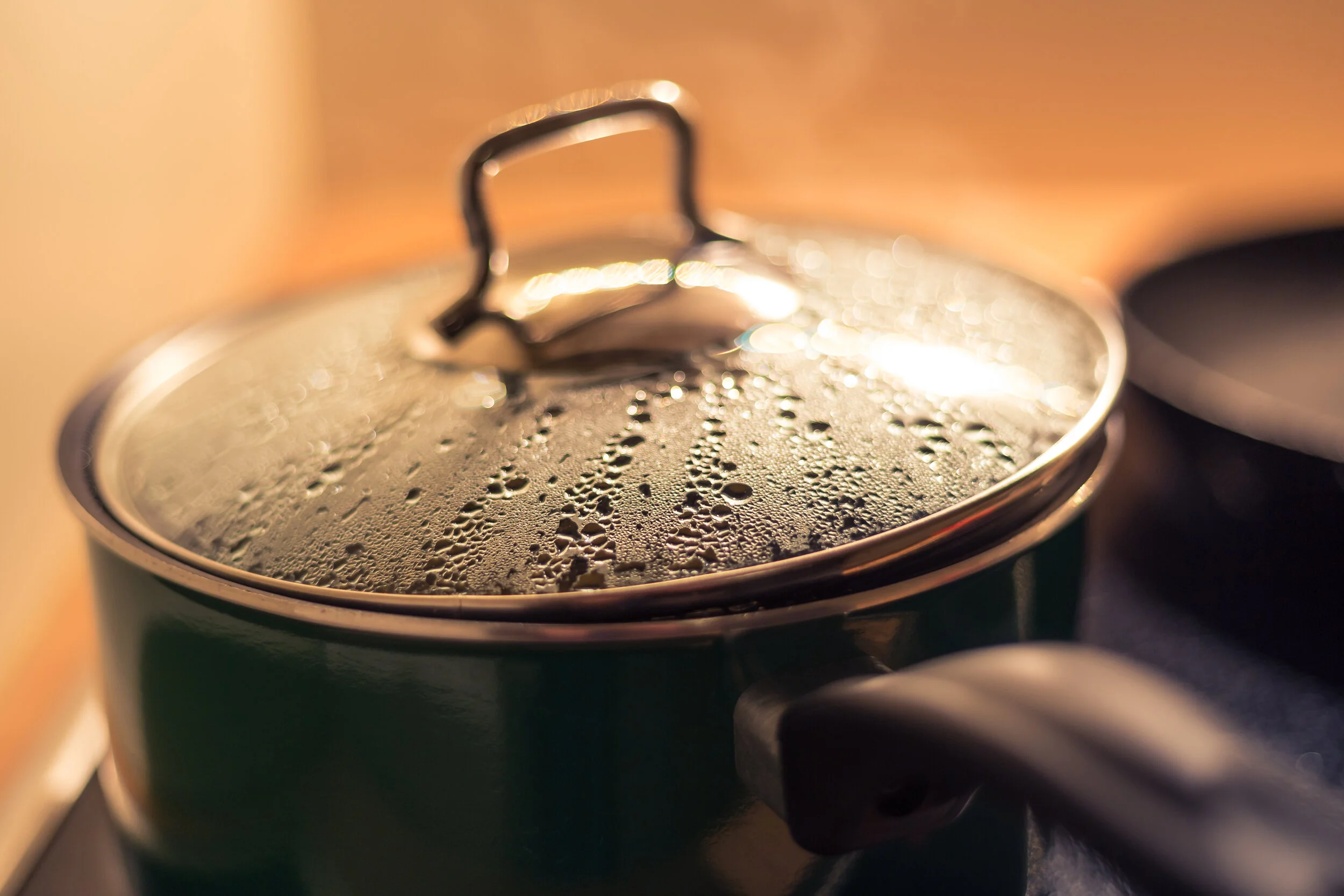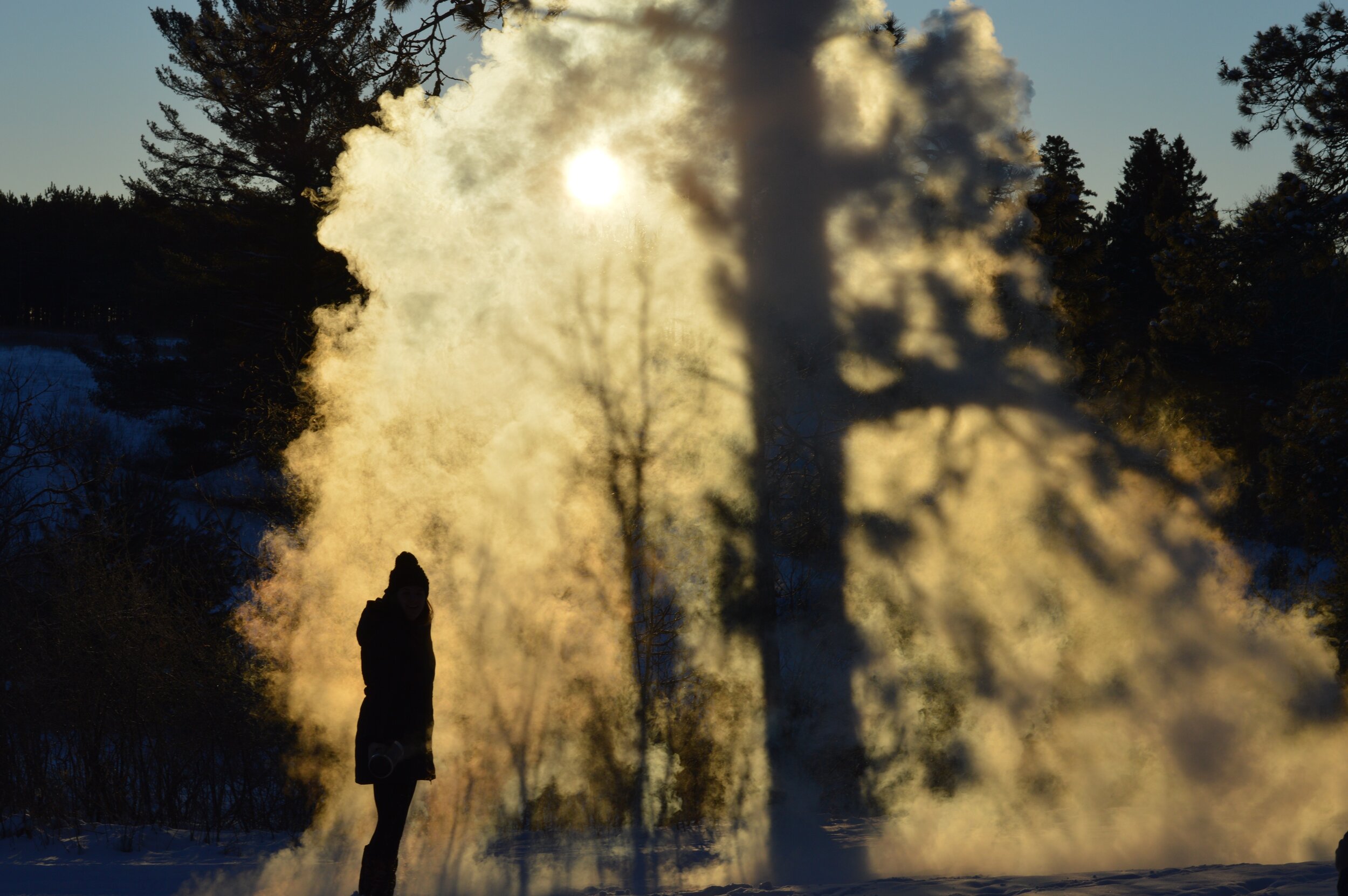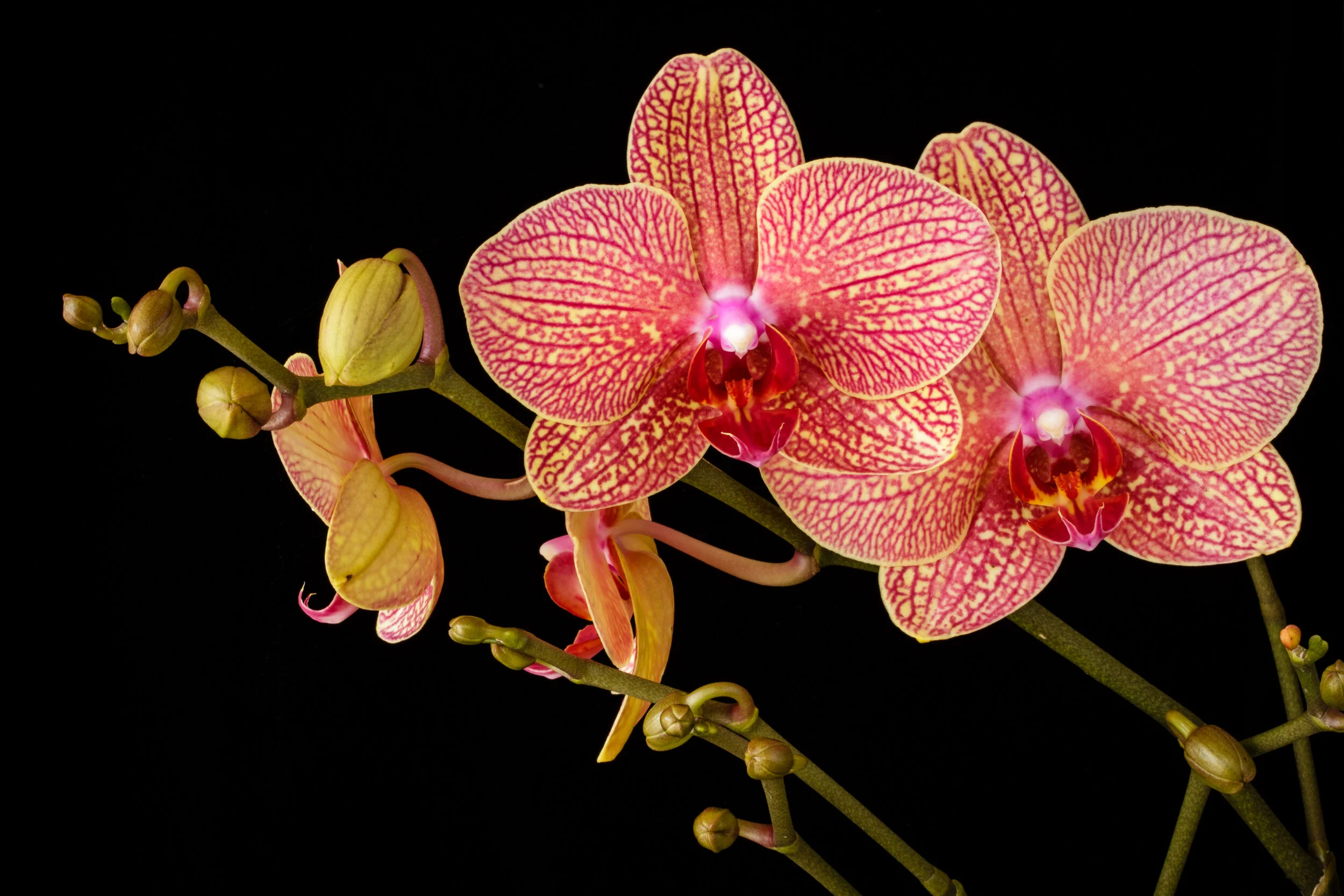Herbal Steams For Health
Steam is a fantastic healing tool with many applications. We can breathe it in, use it to open our pores before cleansing our faces, and to stimulate a fever. Some even use steam to promote vaginal health - this topic is a bit more controversial, and I’ll detail why I don’t recommend this practice and what I do recommend instead!
Breathing in steam:
One of my most frequent suggestions to patients suffering with a sinus infection or productive cough is to breathe in steam. Often, I suggest throwing a handful of thyme, eucalyptus, peppermint, or other herbs on hand into the water. Why would I make this suggestion? Let’s dive in!
Steam is basically hot water that has gone from the liquid form to a gaseous form carrying heat with it. It is something that needs to be used with care as it can cause nasty burns when you get too close. What we want from the steam is twofold: first, we want the heat and second, we want the water.
The heat from the steam is almost magical in its ability to break down sticky mucus. If you’ve ever had a sinus headache from a sinus infection or listened to the cough of a baby with croup, you know how difficult being stuffed with thick sticky mucus makes life. Enter steam, the heat causes the mucus to thin and flow better allowing you to get it out. The water further thins the mucus allowing it to flow more freely. The result, coughing and sneezing and spitting out all that nasty gunk and a clearer head and chest. The bathroom is an ideal location to breathe in steam for this very reason.
If you have a dry hacking spasmodic cough, herbal steams work well to soothe irritated tissues and deliver relaxing antispasmodic herbs right to your airways.
Adding Herbs:
The herbs that work well with steam inhalations are ones with a high essential oil content - pretty much any mint family herb will work as will eucalyptus or evergreen needles. Thyme works particularly well if you have a dry hacking cough as it will relax your airways. Think of smells that open your sinuses but aren’t too irritating - I wouldn’t want to do a steam inhalation of horseradish, garlic, onions, or mustard for example.
Not only will the herbs smell pleasant and help relax your airways, they will also have an antimicrobial action due to their essential oil content. Think of essential oils as plant antibiotics - this is also why we don’t want to ingest them - they are meant to be breathed in and get into your bloodstream that way. When we eat them, they kill off our beneficial gut bacteria and can cause other side effects due to their highly concentrated pharmaceutical nature.
Essential oils are often used, but it’s really easy to overdo it with these powerfully concentrated medications. I like to stick to the plants themselves - this is far more ecologically and economically friendly too! Fresh herbs work best as they still have a high amount of their essential oils intact, but dried herbs that still smell like themselves will also work (you are smelling those oils).
How to do it:
You will need a large pot filled about ¼ - ½ way full with just boiled water, a towel, a handful of herbs, and something to blow your nose on and spit into. I tend to use a t-shirt and a sink for these purposes - just like when I use a neti pot.
Grab your materials and go to a secluded location for some privacy while you hack and spit. Then add your herbs to the surface of the water, bend your head over the water about 8-12 inches from the surface of the water and drape the towel over yourself and the pot. Breathe in the steam through your nose and or mouth. Take breaks for coughing, spitting, blowing and then return to the pot. Continue until you are breathing much easier or the water is no longer steaming - whichever happens first. You can repeat as often as needed.
Steaming your face:
Facial steams are pretty well known and common aspects of beauty care. The heat is used to open the pores of the skin before washing to get a deeper clean and clear out black heads. This warm, moist, open skin is also primed to absorb moisturizers and nutrients. The heat also brings more blood to the surface of the skin allowing better delivery of oxygen and nutrients already located in the blood and removal of unwanted waste products from the cells and spaces between cells.
Adding Herbs:
Herbs that will work well as a face steam are any herbs with skin healing properties. My favorites include: calendula, plantain, St John’s wort, rose, self heal, lavender, yarrow, and chamomile. You will want to work with herbs that you have easily available and that you enjoy the scent of. Rosemary Gladstar has a few different recipes available in her lovely book: Herbal Recipes for Vibrant Health let me know if you would like to check this book out at your next visit.
We’ve talked about herbs that are helpful for the skin previously in last week’s article about wound healing. We’ve also done a deep dive on our skin back in March. You may wish to give these articles a read, or explore some recipes with Calendula my favorite skin herb.
How to do it:
This is done very similarly to the instructions for breathing in steam, but you don’t need to do it for quite as long, and you don’t need to focus on breathing in all that steam but, if you are congested, you can feed two birds with one seed using this treatment.
Once you have your pot of hot steaming water, throw a handful of your chosen herbs in, position your face about 8-12 inches above the water, and cover your head and the pot with a towel. Five minutes will do the trick but you can stay under longer if you desire. Breaks for cool air are allowed of course.
After your steam, be sure to rinse your face well and then apply a spritz of toner like witch hazel or rose water, if desired, and finish up with a moisturizer. I recommend using calendula infused oil if you have it on hand.
Steam Bath
Full body steams are a great way to encourage a good sweat and stimulate a fever when you are coming down with something. Saunas work well, but we don’t all have regular access to one.
Why would you want to encourage a fever? Fevers are your body’s primary defense against infection. Germs that like to feed upon us human hosts like our body temperature of about 98 degrees. When things get hotter, they don’t function very well and our immune cells get the upper hand. This is why fever suppression is not encouraged until your temperature is at or above 103 degrees. Sure, you don’t feel well when you have a fever, but getting rid of your infectio sooner will allow you to feel much better, much sooner reducing how much school or work you need to lose and making you infectious to others for a shortened period of time.
Note - with illnesses such as COVID-19, we want to be careful about a general pro-fever stance. With illnesses such as this, our immune system’s normal brakes are cut allowing our immune system to get out of control and damage our own healthy cells. If you suspect you have an infection with COVID-19, contact your healthcare team and follow their advice. Also be sure to self-quarantine if possible, and follow all CDC guidelines.
Adding Herbs:
The same herbs you would use for breathing in steam will be useful for a full body steam as well.
How to do it:
Instead of creating a towel tent over your head and a pot of steaming water, we will create a blanket tent over your body while you are seated on a chair with a pot of hot steaming water underneath it.
Before you start your steam, be sure to drink a couple glasses of water. You will want to repeat this afterwards too. If you would like to use herbs to promote sweating and support your immune system, try a tea of peppermint, yarrow, and elderflowers.
Gather a chair that will not be damaged by steam (ie not plastic if you can avoid it). Your chair ideally will have openings in the seat but a solid seat will also work. You will also want a blanket that will completely cover you and drape down to the floor when you are sitting on this chair. A basin of warm water for your feet and a pot of hot steaming water with a handful of herbs (or not) will round out your supplies.
Position the pot of steaming water under the seat of your chair - be sure that any exposed areas of skin will be at least 8-12 inches above the water to avoid scalding your sensitive areas. Place the foot basin in front of the chair. Remove all clothing, sit on the chair with your feet in the basin and wrap the blanket around your body. Stay in this position until you have developed a good sweat. You can then either wrap up in the blanket and lie down to continue sweating or you can take a cool shower to fully rinse the sweat off depending on your reasons for doing your full body steam. If you are working to promote a fever, lay down until you finish sweating and then be sure to rinse your skin off fully to prevent skin irritation. If you were just looking to sweat, go ahead and take that cool shower.
Vaginal steaming?!?!
I will be completely transparent and admit that I have not tried this therapy. I also do not see it promoted in the herbal and medical resources that I frequent, but out of curiosity and for this article, I decided to do some investigation. I did not go so far as to take a course on the topic, but if you are interested, there is a $12 one through Udemy.
Herbalists such as Rosemary Gladstar and Dr. Rosita Arviga are known to promote this treatment, and there are many health claims associated with this therapy. Claims include: reduced bloating, improved menstruation, treatment of vaginal infections, improving vaginal and uterine tone amongst many others. The setup is very similar to the full body steam, but you will want a chair with an open seat to allow full steam access to your genitals. Herbs are added to the water that have skin healing attributes such as calendula and lavender as well as astringent herbs that tonify tissues such as yarrow and rose.
While I have nothing against this treatment and will most likely try out the experience at some point, there is a similar but different treatment that I prefer.
Alternating hot and cold sitz baths or pelvic showers
With the vaginal (or yoni) steam, you are getting half the benefit of this treatment - the heat. Unfortunately, you miss out on the healing action of following heat with cold. Heat will bring blood flow to an area which has many benefits, but it leaves the tissues swollen and engorged with blood. When we follow the heat treatment with cold, this will push blood out of the area taking away waste products and reducing swelling. It’s like a pumping action. Bring in fresh blood then carry away waste products flushing the area. You can use herbs just as you would with a steam, but you can also be a bit more strategic about it.
Sitz baths are basically a bath that covers your pelvic area - think of a basin just deep enough to sit in that will hold water up to about your belly button. You will need two of these. One hot and one cold. You can make a strong tea of healing herbs such as calendula, oats, plantain, and self heal for your hot water and another tea with astringent tonifying herbs for your cold water - yarrow and rose work well.
Pelvic showers are simpler and easy to do during your regular shower but it’s hard to add herbs into this treatment unless you have a fancy showerhead that would allow you to pack herbs in (I have no idea if this is a thing). Here you will want a detachable showerhead that you can spray hot and cold water onto your neatherregions with.
How to do it:
Sitz baths -
Fill your basins with water, one hot and one cold. If you are using herbs, be sure to add your teas in as well.
Sit in the hot basin for 10-15 minutes.
Move to your cold basin and sit in here for 3-5 minutes
Repeat for a total of 3 cycles
Pelvic shower -
Using your shower head, direct a hot but not scalding stream of water to your perineum (the area between your anus and your sex organs) for 3-5 minutes.
Then turn the water to cold, not so cold it’s unbearable but cold enough that it is a contrast to the hot water. You may need to work up to this over time. Direct the stream of cold (or cool) water to your perineum for 30 seconds to 1 minute.
Repeat for a total of 3 cycles
I hope you have enjoyed learning about a new way to use herbal medicine and a bit about hydrotherapy as well. We will continue our exploration of the uses for different spaghetti herbs like thyme next week and round out the month of July with some great recipes that feature these tasty kitchen herbs. I’m currently open to suggestions for August’s herb of the month. Feel free to leave a comment below, let me know at your next visit, or tell me at our next member meeting where we will be having fun making herbal tinctures.
To our health!





